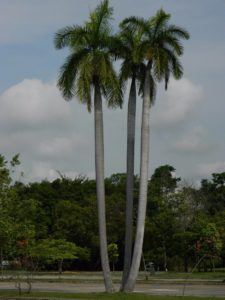 LA PALMA REAL CUBANA, CUATRO VECES SANTA.
LA PALMA REAL CUBANA, CUATRO VECES SANTA.
La palma real, el árbol nacional de Cuba se considera sagrada para todas las religiones de origen africano. Los congos o seguidores de la Regla de Mayombe o Palo Monte la conocen como Dunkede, Diba, Lala o Mábba.
Cuando es impactada por un rayo, los seguidores de esta religión llegan hasta ella a recolectar las “Piedras de rayo”, con las cuales se montan las ngangas. En estos recipientes se combinan diversos elementos que dan la fuerza, el espíritu y el alcance del seguidor.
Según los mayomberos en la palma real reside Nsasi y por esa razón bajo esta planta es que se realizan las ceremonias de iniciación, se curan a los enfermos y se colocan ofrendas. Varias partes del árbol se utilizan en la fabricación de objetos mágicos de gran poder que sirven para realizar las prácticas exorcistas.
En la Regla de Ocha o Santería, la más extendida de las religiones de origen africano en Cuba, la palma real es conocida como Alabi, Opwé, Iggi o Ilé Changó Orissá. En ella vive Changó, uno de los orishas más poderosos, que reina sobre los tambores, el fuego, los truenos y la guerra. Desde la punta de las palmas, el orisha vigila y protege a sus hijos. De ahí que el árbol tenga presencia notable en los rituales y en la fabricación de objetos religiosos.
Los abakuás o ñáñigos nombran a la palma real Ukano Mambre y afirma que fue a los pies de este árbol en que se fundó la primera hermandad; por lo que posee un gran simbolismo y se le considera como una potencia sagrada.
Por último, para los practicantes católicos en Cuba, la palma real también posee importancia. Ellos conservan algunas de las costumbres heredadas de los españoles y el Domingo de Ramos, que inicia la Semana Santa, los creyentes salen a las calles en procesión portando hojas de palma que luego conservan en sus casas como reliquia.
En esa festividad el guano se consagra en oraciones y se rocía con agua bendita para entregar a los fieles. También se adornan iglesias y altares con las hojas y se quema el Miércoles de Ceniza para marcar la frente en símbolo de penitencia y arrepentimiento durante la Cuaresma.
 THE CUBAN PALMA REAL: FOUR TIMES HOLY.
THE CUBAN PALMA REAL: FOUR TIMES HOLY.
The real palm, the national tree of Cuba is considered sacred for all religions of African origin. The congos or followers of the Rule of Mayombe or Palo Monte know it as Dunkede, Diba, Lala or Mábba.
When struck by lightning, followers of this religion come to her to collect the “Stones of lightning,” with which the ngangas are mounted. In these vessels combine various elements that give the strength, spirit and reach of the follower.
According to the mayomberos in the real palm resides Nsasi and for that reason under this plant is that the ceremonies of initiation are realized, the sick are cured and offerings are placed. Several parts of the tree are used in the manufacture of magical objects of great power that serve to perform the exorcist practices.
In the Regla de Ocha or Santería, the most widespread of religions of African origin in Cuba, the royal palm is known as Alabi, Opwé, Iggi or Ilé Changó Orissá. In it lives Changó, one of the most powerful orishas, who reigns over drums, fire, thunder and war. From the tip of the palms, the orisha watches and protects his children. Hence, the tree has a notable presence in rituals and in the manufacture of religious objects.
The abakuás or ñáñigos name the real palm Ukano Mambre and affirm that it was at the foot of this tree that the first brotherhood was founded; so it has a great symbolism and is considered as a sacred power.
Finally, for Catholic practitioners in Cuba, the royal palm also has importance. They preserve some of the customs inherited from the Spaniards and Palm Sunday, which begins Holy Week, the believers take to the streets in procession carrying palm leaves that they then keep in their houses as a relic.
On that holiday the guano is consecrated in prayers and sprinkled with holy water to deliver to the faithful. Churches and altars are also decorated with leaves and Ash Wednesday is burnt to mark the forehead as a symbol of penance and repentance during Lent.
Agencies/ TodoCuba/ Internet Photos/ Arnoldo Varona/ www.TheCubanHistory.com
THE CUBAN HISTORY, HOLLYWOOD.







